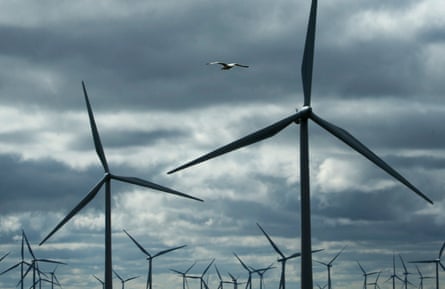Nowhere does landscape marry passion quite so much as in Yorkshire’s Wuthering Heights. The tempestuous Pennine contours and tumbling streams perfectly frame Emily Brontë’s turbulent romance. Wild storms and dark gullies echo the cries of Heathcliff, Cathy and sexual jealousy. From moorland peaks to the historic Brontë village of Haworth below, the scene is unspoilt.
I cannot think of any British government for half a century that would have dreamed of destroying this place. Yet the energy secretary, Ed Miliband, apparently wants to do so, with the largest onshore windfarm in England, the Calderdale Energy Park. He clearly regards this unique landscape as the perfect spot for 41 giant wind turbines, each no less than 200m tall. Their height would top Blackpool Tower by 40m.
This is near unbelievable. The glorious Pennine Way, which traverses the area, would be reduced to a stroll through an industrial park visible for miles around, one of roads, depots and servicing trucks. The Saudi-backed firm behind the scheme, Calderdale Wind Farm Ltd, only recently agreed not also to coat the surface peat in solar panels.
At the end of this month, a demonstration of about 500 protesters will re-enact Kate Bush’s ballad Wuthering Heights on Penistone Hill, immediately overlooking Haworth. They follow a parliamentary petition of 15,000 signatures and cries for help from defenders of the moor’s site of special scientific interest and various other now-enfeebled landscape protections.

The arguments Miliband uses for onshore wind power are familiar. Even though Britain’s contribution to net zero can only be negligible, he wants to show willing. He and Keir Starmer take a peculiar delight is deriding opponents of their renewable projects as nimbys. To them, the defenders of Yorkshire’s moors are fuddy-duddy romantics deaf to global salvation and to Britain’s need for growth.
The language in which we conduct these debates matters. Yes, renewable energy is a good idea and the world needs to move in that direction. But as soon as the general is reduced to the particular, judgments have to be made and compromises reached. Many argue that the cost of Britain’s net zero – a political ambition rather than a plausible target – contributes towards UK households paying some of the highest energy bills in the world. The basis of these bills, and Miliband’s unrealised pledge to reduce them, is a series of near-incomprehensible algorithms. We pay huge subsidies to renewable companies and pour money into reckless nuclear plants.
The present government does nothing to curb the construction industry, one of the biggest emitters of carbon at 25% of the nation’s total. The environmental audit committee protested in 2022 that not a single government measure had aimed to curb this, and there has been no action since then. The reason is simple. This government equates construction with growth, which takes precedence over net zero. The Treasury imposes VAT on all building conversion and retrofitting, yet it exonerates carbon-intensive new building completely. In effect the British taxpayer is subsidising global heating. The hypocrisy is blatant.
Clearly a judgment should be made as to where, if anywhere, onshore wind turbines should be located. They are peculiarly intrusive, imposing their presence, their height and their motion on their surroundings. I have seen them sited in industrial zones and brownfield areas, to which it is hard to take exception. I have also seen them wreck rural Northamptonshire and they are about to deface the mountains of mid-Wales.

The obvious place for them is offshore on the shallow shelf around the British Isles. There they are less intrusive and less controversial. But since onshore is cheaper, Miliband has reversed the previous policy bias against it and is eager to get building. He dismisses opposition as self-interested, and has removed any power that local councils might use to oppose him.
Unless we rediscover a language to discuss the beauty of place, we cannot conduct this debate. Money will always do the talking. When town and country planning was formalised in the 1940s, it was on the basis of a consensus that certain landscapes were beautiful and should enjoy protection. When town conservation areas were introduced in 1967, the same consensus applied. There was an assumption of aesthetic value that has obtained ever since. It is plain that it no longer does so.
I am not aware of the present government having ever deigned to mention beauty with regard to the environment, built or natural. That a foreign conglomerate can honestly expect to be subsidised by the British taxpayer to wreck the Pennine Hills suggests a cabinet with no idea what merits protection and what does not.
I would like to see how Miliband’s Camden neighbours would react if he proposed a field of 200m turbines on the slopes of his local beauty spot, Parliament Hill Fields. He might argue that the turbines should be cheap to build and need few pylons to get to market. He might say Camden has a duty to save the world, and might even knock a hundred quid off local energy bills, as he has suggested elsewhere.
But I imagine Miliband’s Hampstead backyard would erupt as never before. If he then gave way to them, what would be his argument?
I rather wish Miliband would indeed try a turbine park in Parliament Hill Fields. We might learn a lot.
-
Simon Jenkins is a Guardian columnist

.png) 3 months ago
56
3 months ago
56

















































